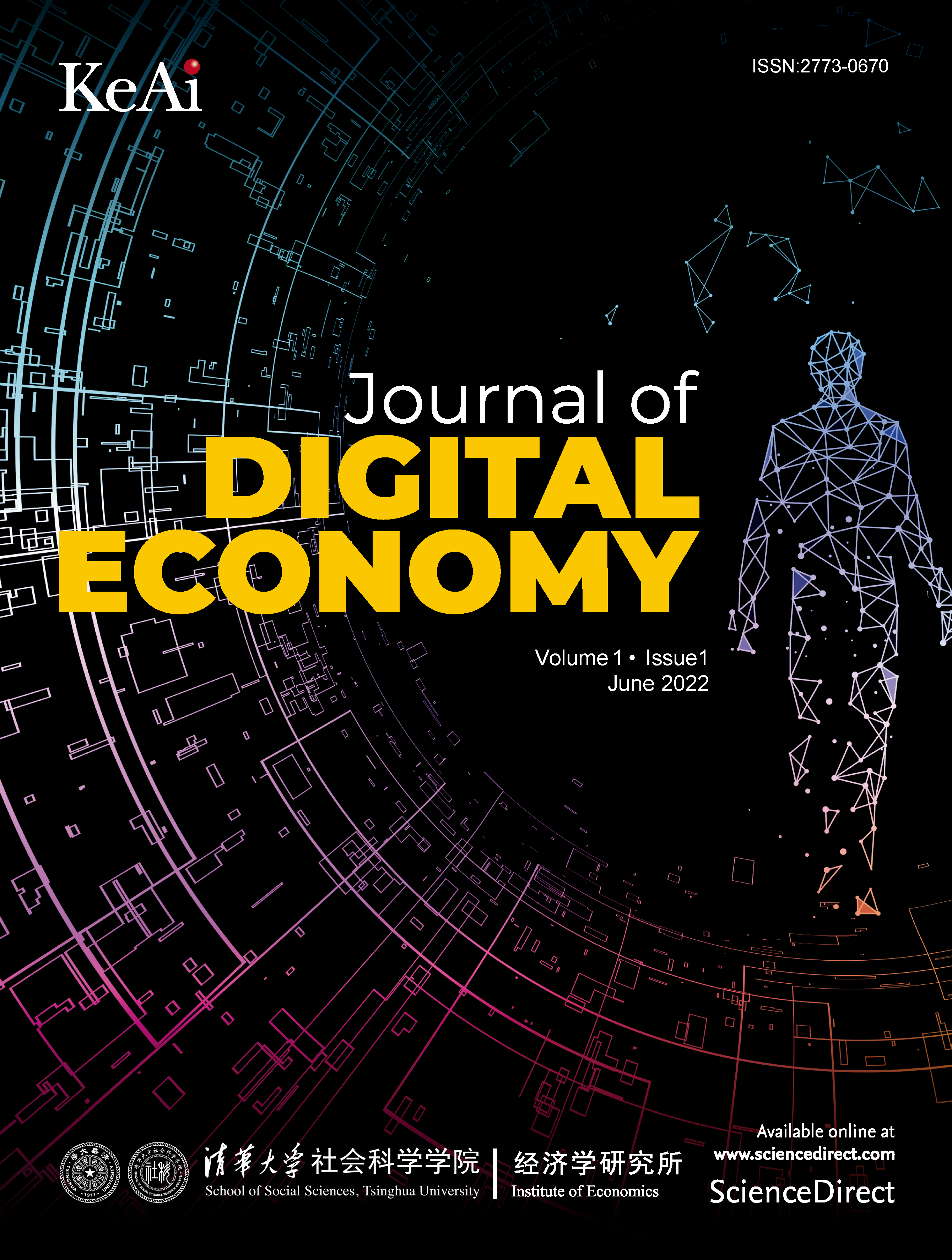博文
数字经济中的工业化和数字化(FID)融合:工业系统数字化、数字技术工业化等|Journal of Digital Eco
||
近期刊载于Journal of Digital Economy期刊的论文"Fusions of industrialisation and digitalisation (FID) in the digital economy: Industrial system digitalisation, digital technology industrialisation, and beyond"基于最近两个案例的观察,讨论了工业化与数字化的融合,并提出工业化与数字化融合可以分为三个过程和一个新的转化结果。
从流程的角度来看,首先,被描述为工业系统数字化的融合可以通过在现有工业系统中采用数字技术,特别是在其薄弱环节,有效地提高竞争属性。其次,被描述为数字技术工业化的融合提供了一种新的服务模式,以成功的数字应用为基础创建一个新的产业。第三,融合作为上述两个过程的整合,可以在上述两个过程之间建立一个互反迭代的过程,最终实现有效、健康的自我进化。此外,从演变结果的角度来看,融合可以被视为元宇宙内以及虚拟和现实世界之间的一套互动机制和原则。
世界已进入一个令人兴奋的数字演变新阶段,在这个阶段中,工业系统正在进行数字转型,而个别数字技术正在以新的商业模式有效地工业化。工业化和数字化的融合有可能从根本上提升中国的工业体系,进一步培育商业生态系统。然而,如何实现融合和演变仍然是学术界和实践界面临的一个严峻的挑战问题。
在第一次融合的情况下,即工业系统的数字化,本文回顾了产品设计、采购和采购、生产和服务阶段的数字化转型,以及工业系统的设计、运行和持续改进的一般管理过程。总结了转化的五步一般过程。
在第二次融合即数字技术工业化的情况下,本文开发了一个迭代过程模型,包括积累经验、生成商业模式、建立产业、运营和改进,最后将产业系统嵌入生态系统的五个阶段。在描述的两种融合的基础上,描述了工业系统的数字化和数字技术的工业化之间进一步的互动关系。提出工业系统的数字化触发数字技术的工业化,最终形成一个迭代循环,在一个新的工业中触发一个工业系统的数字化。
在这两种融合的循环往复之后,本文进一步从四个相互关联的角度探讨了更广泛的可能结果:融合形成了一个工业系统的虚拟化过程;虚拟化创造了一个虚拟世界;虚拟世界与现实世界互动;这种迭代培养了一个新的行业,在这个行业中,现实世界和虚拟世界相互作用。最后,在4C(语境、配置、能力、协同进化)解构框架下,比较了经典产业与新兴产业的差异。
文章信息
Fusions of industrialisation and digitalisation (FID) in the digital economy: Industrial system digitalisation, digital technology industrialisation, and beyond
Yongjiang Shi, Yibo Gao, Yining Luo, Jialun Hu

作者简介

Yongjiang Shi
英国剑桥大学副教授,现任英国剑桥大学国际制造与管理研究中心主任,研究领域为工业系统与全球化、中国制造与演化、可持续发展工业系统。

Jialun Hu
伦敦大学皇家霍洛威学院高级讲师(副教授),研究领域为低碳管理与金融、商业智能分析、可持续发展工业系统、供应链运营管理。

Yibo Gao
剑桥大学制造研究院博士,研究领域为产业升级与融合,区域商业生态系统。

Yining Luo
剑桥大学制造研究院博士生,研究领域为数字经济与新兴产业,创新/商业生态系统。
#
期刊简介
工业革命将人类从早期的农业社会转变为工业化时代,而21世纪则见证了数字文明的崛起。Journal of Digital Economy (JDE)由清华大学社会科学学院经济学研究所与科爱共同创办,致力于阐明这个数字时代是如何扩展、重组和挑战现有知识和传统方法的。JDE是一个多学科的平台,包括但不限于经济学、管理学、社会学、政治经济学,计算机科学和环境科学。JDE研究如何在数字时代提高经济福祉、社会公平和环境可持续性。JDE欢迎以实践和政策为导向的研究,以应对我们这个时代特有的挑战和利用机遇。
主编

戎珂
清华大学社科学院经济学所
清华大学长聘教授、博导
研究方向为商业/创新生态系统、数字经济和数据生态
推荐阅读
数字化转型项目会失败的原因以及如何利用数据架构|Journal of Digital Economy
将人的价值引入生态系统发展:人本生态系统|Journal of Digital Economy
人工智能伦理治理: 一个整合性分析框架|Journal of Digital Economy
Fusions of industrialisation and digitalisation (FID) in the digital economy: Industrial system digitalisation, digital technology industrialisation, and beyond
Summary: This paper discusses the fusion of industrialisation and digitalisation built upon two recent case observations, and suggests that industrial–digital fusion can be divided into three processes and one new transmuted outcome. From the process perspective, firstly, fusion described as the digitisation of industrial systems can effectively improve competitive attributes through the adoption of digital technologies in existing industrial systems, especially in its weak links. Secondly, fusion described as the industrialisation of digital technology provides a new service model to create a new industry based on successful digital applications. Thirdly, as the integration of the above two processes, fusion can establish a reciprocal and iterative process between the above two processes and eventually achieve self-evolutions effectively and healthily. Additionally, from the transmutation outcome perspective, fusion can be recognised as a set of interactive mechanisms and principles within the metaverse and between virtual and real worlds.
Main text: The world has entered an exciting new stage of digital transmutation in which industrial systems are digitally transforming while individual digital technologies are efficiently being industrialised with new business models. The fusion of industrialisation and digitalisation has the potential to fundamentally enhance Chinese industrial systems and further nurture business ecosystems. However, how to achieve the fusions and transmutations remains a serious challenging issue for both academic and practical communities. In the case of the first fusion, namely the digitalisation of industrial systems, the paper reviews the digital transformation for product design, sourcing and procurement, production and servitisation phases as well as the general management processes of design, operation and continuous improvement in industrial systems. A five-step general process of transforming is summarised. In the case of the second fusion, namely the industrialisation of digital technology, the paper develops an iterative process model with the five stages of accumulating experience, generating business models, building up industry, operating and improving and finally embedding the industrial system in the ecosystem. On the basis of the two fusions described, a further interactive relationship between the digitalisation of an industrial system and the industrialisation of digital technology is depicted. It is proposed that the digitalisation of the industrial system triggers the industrialisation of digital technology and eventually forms an iterative cycle that triggers the digitalisation of an industrial system in a new industry. Following the iterative endless cycle of the two fusions, the paper further explores broader possible outcomes for four interconnected perspectives: the fusions form a virtualisation process for an industrial system; the virtualisation creates a virtual world; the virtual world interacts with the real world; and the iterations nurture a new industry in which the real world and virtual world interact. The paper finally compares the differences between the classical industry and new industry within the 4C (context, configuration, capability, coevolution) deconstruction framework.
https://blog.sciencenet.cn/blog-3496796-1359745.html
上一篇:将人的价值引入生态系统发展:人本生态系统|Journal of Digital Economy
下一篇:KeAi Talks┃SUSOC系列研讨会 「Open for Climate Justice 」